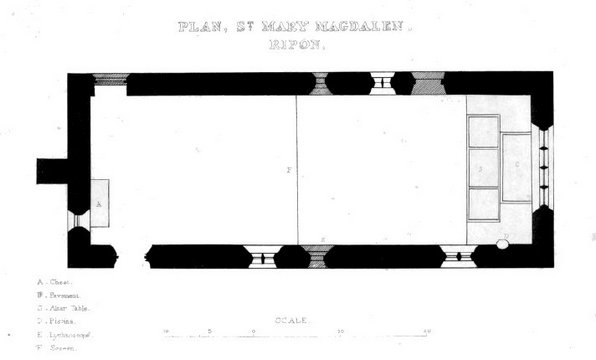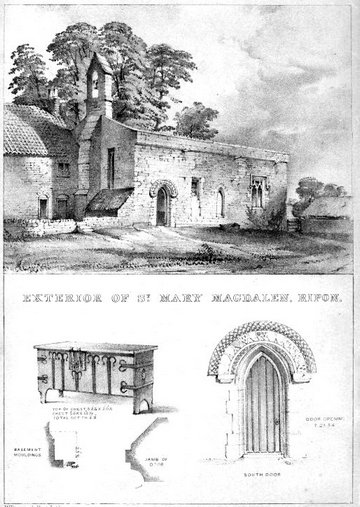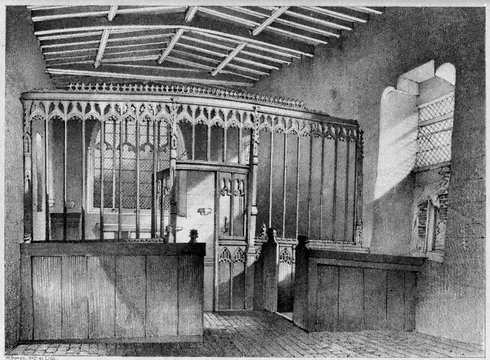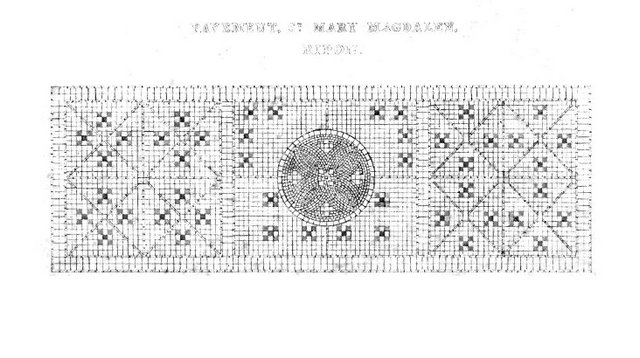Hide
The History of the Chapel of St. Mary Magdalen, Ripon
hide
Hide
Hide
RIPON:
The History of the Chapel of St. Mary Magdalen, Ripon
Source=h:/!Genuki/RecordTranscriptions/WRY/YorksChurchesWRY.txt
The Chapel of
St. Mary Magdalen,
Ripon
IT has always been our intention to intersperse the notices of the finer Churches of Yorkshire, with some account of ecclesiastical edifices of smaller size and less gorgeous character, where there is anything of peculiar note, and especially of practical importance, in their structure. And the chapel attached to the ancient hospital of St. Mary Magdalen, in Ripon, offers itself among the most worthy of attention.
There is of course no parochial history to a little chapel attached to an almshouse, and from its first erection of very inferior importance to other ecclesiastical foundations in the same place. As much as is necessary to be known about it, may be collected from the following extracts from Dugdale's Monasticon.
" HOSPITAL OF ST. MARY MAGDALEN, AT RIPPON, IN YORKSHIRE.
"' The Hospital of St. Mary Magdalene for lepers here,' says Leland, ' is on the hither ripe of the Skelle, and is of the foundation of the archbishops of Yorke.' It was founded by archbishop Thurston, who died A.D. 1139, first for a chaplain and sisters, and for the relief of all the lepers in Richmondshire. Afterwards here was a master, two or three chaplains, and some brethren. It was valued in the 26th lien. VIII, at £27 Ss. 6d. in the total, and at £24 Os. 7d. in the clear income.
" There is a certificate of colleges, hospitals, &c., suppressed by King Henry the VIII. in the Augmentation office, wherein it is stated that Marmaduke Bradley, incumbent, is master of the same; showing no foundation, but used there to keep two priests and five poor people, to pray for all christian sowles, having for his stipend £4, and every of the five poor people Os. 8d.' The total value of the lands, £31 3s. 6d.
" No seal of this hospital has been met with by the present editors," (viz. of Dugdale's Monasticon in 1830.) Then follow these records :
" Num. I.
" De prima Fundatione Ejusdem.
" [Placita coram Rege, term. Mich. 19 Edw. III. Rot 45. Ebor.]
" Dominus rex misit breve swum quibusdam commissaries, ad inquirendum de defects custodiæ hospitalis Riponensis: qui per juratores returnaverunt, quod quidam Thurstanus, quondam Archiepiscopus Ebor. fundavit dictum Hospitale, ad sublevamentum, &c. Et quod custos ejusdem dispensit proficua ejusdem, nesciunt, &c."
" [Es. 15. Edw. III. u. 73.]
" Inquisitio super state ejusdem.
"Juratores dicunt, quod quidam Archiepiscopus Ebor. fundavit dictum hospitale, cujus nomen ignorant; et Archiepiscopi Ebor. qui pro tempore fuerunt, et dominus rex Angliae, sede Archiepiscopali Ebor. vacante, sunt veri patroni dicti hospitalis. Et dictus archiepiscopus prædicti hospitalis fundator, dedit dicto hospitali unam placeam terræ et boscum in Ripon, qui vocatur Dunscewith, sicut includitur fossatis, super qua fundatur hospitale praedictum, et valet per annum es. Item dedit dicto hospitali unam carectatam vel duas carectatas bosci de Northscogh. pro focali, qualibet septiman? optinend?, et pasturam in Northscogh ad octo boves, decem vaccas, unum taurum, quinque sues, cum sequel? sua, trium annorum ; de precio tamen pasturae nihil sciunt dicere. Item dictum hospitale donatum fuit per eundem archiepiscopum, ad percipiendum de qualibet carucata terræ arabilis in Ripschire, unam travam de quolibet genere bladorum, et valet per annum xxs. quae omnia collata fuerunt primo sororibus in dicto hospitali, quasi religiose viventes, ad inveniendum quendam capellanum, diving in eodem hospitali celebrantem, et ad sustentandum omnes leprosos in Ripschire procreatos et genitor, ad dictum hospitale venientes, et ad ministrandum cuilibet leprosorum unum indumentum, quod dicitur Bak, et duo paria sotularium per annum; et quolibet die unum panem, pro sustentatione unius hominis sufficientem, dimi-diam lagenam cervisiae, unam unciam carnis, die carnium, et tria allecia quolibet die piscium. Et postea ad augmentationem dicte eleemosinae, date fuerunt per diversos homines, dicto hospitali xxxiii acre terrae in campis de Ripon, quae valent per annum xxxvis. argenti, annuus redditus sex marcarum in villis Ripon et Newby. Item tertia pars vale de Ilketone, cum pertinentiis data fuit dicto hospitali, ad inveniendum quendam capellanum celebrantem ibidem pro anima Willielmi de Homelyn, quae pars valet per annum quatuor libras.
" Item manerium de Mullewathe, cum pertinentiis suis, est adquisitum dicto hospitali quod valet per annum xii marcas. Item dicunt, quod ante capella dicti hospitalis dedicata fuerit, nesciunt; sed sepultura hominum decedentium in dicto hospitali habetur ibidem, ex licentia tamen capituli Riponensis. Item dicunt, quod Johannes le Waryner, dedit eidem hospitali, tempore domini regis, qui nunc est, manerium de Stodley Roger, ad inveniendum duos capellanos in eodem hospitali celebrantes, ipso vivente; et post obitum suum tres capellanos perpetuo celebraturos; sed dictum hospitale oneratur eidem Johanni in xii marcis ennuis, ad totem vitam suam. Item dicunt, quod magister dicti hospitalis, qui pro tempore fuerit, non solvit decimas de placea, nec de bosco de Dunscewith, neque de duabus acris terrae predictis, eo quod magister dicti hospitalis et servientes sui in eodem, molunt libere aliqua multura ad molendum, quod dicitur Northmylne Archiepiscopi.
" Dicunt insuper, quod defunctis dictis sororibus hospitalis predicti, Archiepiscopus Ebor. qui tune fuit, contulit dictum hospitals cuidam Roberto de Silkestone capellano, ad inveniendum et sustentandum eleemosinam praedictam, videlicet cantarias et leprosos. Item dicunt, quod Johannes de Bridesing clericus, et in ordine accolicatus constitutus, est magister dicti hospitalis, ex collations domini Willielmi de Melton, nuper Ebor. Archiepiscopi; etfuitper unum annum et dimidium proximum praeteritum magister ibidem. Item requisiti an eleemosina praedicta alia onera dicto hospitali incumbentia sustentantur et supportantur, ut deberent; dicunt quod quidam capellanus est subtractus toto tempore magistri, qui nuns est, et nullus leprosus est ibidem, et per magistrum non stat, quia nulli venerunt, nec veniunt ibidem, non fuerunt ibi fratres nec sorores. Item quod eleemosina datur pauperibus quolibet festo beate Marie Magdalene. Item dicunt quod staurum domus, agricultura, et divina officia ejusdem hospitalis, exceptis dicto capellano subtracto, et quadam domo in qua solebant leprosi manere, quae prostrata fuit tempore Henrici de Shirehake, quondam magistri dicti hospitalis, et sic est adhuc, bene custodiuntur. Item requisiti an facta sit alienatio, seu dilapidatio bonorum, possessionum et jurium dicti hospitalis; dicunt quod dominus Willielmus de Melton, nuper Eborum Archiepiscopus spoliavit dictum hospitals, tempore Henrici de Shirehake, de tribus aerie terrae, duabus acris prati, tota pastura pro animalibus praedictis, et focali prædicto in dicto parco de Northscogh; et jam sunt ista subtracta in manu domini regis, qui nunc est. Item requisiti an magister, qui nunc est, prosecutus fuit jura predicta; dicunt quod non potuit, propter brevitatem temporis sui et mortis ultimi archiepiscopi. Item dictum hospitale non oneratur, nisi in duodecim morels, dicto Johanni de Waryner et duobus capellanis prædictis, solvendis ex causa praenominata. Dicunt etiam, quod magister et capellani sui praedicti stint bonae famae, et conversationis honestæ, et sic reputantur in villa Ripon; et quod dictum hospitale fundatur de possessionibus temporalium tantum."
Abstract of valor ecclesiasticus, 26, Hem. VIII.
HOSPITALE BEATAE MARIAE MAGDALENAE IN RIPON.
MARMADUCUS BRADLEY,* Incumbens,
| Com Ebor' | £. s. d. |
| Ripon-Mansio cum gardino &c. | 9 6 8 |
| Mulwath-Redd' et firm' | 8 0 0 |
| Nether Stodley-Redd' et firm' | 4 3 4 |
| Ilkton-Redd' et firm' | 2 12 8 |
| Ripon-Redd' et firm' | 2 3 4 |
| Newby-Redd' et firm' | 0 13 4 |
| Staynbriggat-Redd' et firm' | 0 6 2 |
| Total | 271. 5s. 6d. |
* Marmaduke Bradley became abbot of the neighbouring monastery of Fountain's, A.D.1537.
"Num. IV. .
" Veredictum juratorum super statu Hospitalis de Ripon anno decimo Regis Edwardi Secundi.
" [Ex bundello brevium Regis de tempore Regis Edwardi III. n. 64.]
"Inquisitio capta die dominica in octabis beatae Mariae virginis apud Ribstan coram escaetore domini regis citra Trentam, anno regni regis Edwardi filii regis Edwardi decimo, juxta formam brevis et huic inquisitioni annexam, per Henricum Biome, Robertum de Haltone &c., juratos; qui dicunt super sacramentum suum, quod in Hospitali Beatæ Mariae Magdalenæ in brevi contento, debent esse imperpetuum, secundum formam fundationis ejusdem hospitalis cotidie duo capellani divina celebrantes ; unde, per totum tempus Nicholai de Molyns custodis ibidem subtrahitur cantaria unius capellani per eundem Nicholaum.
"Item quoad hospitalitates dicunt; quod si peregrini, vel clerici mendici, seu cmteri indigentes, per idem hospitale forte itinerarent, seu vagi migrarent, in eodem hospitali per unam noctem haberent refugium, et hospicium, et de victu et lecto, ita quod mane praetereant, unde nullus ibi habet refugium, victum, nec lectum; sed vacu? manu recedunt. Quoad elemosinas faciendas, dicunt, quod die beatae Mariae Magdalenæ annuatim imperpetuum, cuilibet pauperi venienti, debet distribui unus panic fratri, valens obolum, quarterio frument valente quinque solidos; et unum allec, unde per totum tempus dicti Nicholai elemosina haec per eundem Nicholaum subtrahitur; sed loco hujus dat pauperibus dicto die Magdalenæ venientibus, unum salsarium fabarum, seu farinae plenum ; sed major pars pauperum nihil inde possidebunt. Dicunt etiam, quod minuta opera caritativa, guae ab hujusmodi hospitali, et praecipu? ab hoc deberent emanare nulla inde fuerint, occasione absentiae suae, quia raro ibi residet; cum tamen residere teneatur, omnia haec per Nicholaum de Molyns custodem ibidem, per tempus suum integrum subtrahuntur, et adnichilantur."
The Chapel
 The ground plan of this little edifice, is extremely Ground Plan. simple. It is an oblong parallelogram, with no distinction without, between the choir and the ante-chapel ; and without tower, aisles, porch, or vestry.
The ground plan of this little edifice, is extremely Ground Plan. simple. It is an oblong parallelogram, with no distinction without, between the choir and the ante-chapel ; and without tower, aisles, porch, or vestry.
Exterior.
The exterior view of the chapel given in this number, is that which presents itself on the approach from the town, and it will at once appear, that its character is due chiefly to the bell gable, rising over the west end above a strong and far projecting buttress. It contains one bell. The south-door retains in the round head billet and zigzag-like (for it is not the true zigzag) mouldings, traces of the Norman foundation. Passing eastward, the first window is partially, the second wholly blocked up. Beyond this the different masonry indicates that this has been more recently extended. All westward is Early English, except portions of the door, before noticed as Norman ; and the rest is late and poor Perpendicular. At the north, the first window, eastward, is badly inserted under a round arch; the second is Early English, trefoil headed, and with a rude dripstone terminating in notch heads, following the line of the trefoil. The aperture is four feet three inches by eleven inches, and it is two feet four inches from the ground, the one opposite is three feet three inches from the ground.
There is a doorway blocked up at the north east ; and another also blocked up opposite the south entrance. The west gable has but one window, Early English, tre-foiled, of very long proportions. Uniformity would demand another window on the north of the buttress, but we found no traces of any, and surely the chapel is far prettier without.

Interior.

 The interior is as simple and as rude in its details as the exterior. We have already observed that the windows are of various dates and proportions. Their want of all uniformity becomes more apparent within, when all are seen at once. The east window is Perpendicular, of four lights, subdivided and trefoiled at the head. On the south, within the screen, is an inserted square-headed Perpendicular window of two lights, and much lower is one of Early English date, answering, in its position and height from the ground, to the " Lychnoscope"* of the Cambridge Camden society. On the north side, within the screen, are also two windows, but not corresponding with those on the other side. Westward of the screen there is no north window, nor ever has been ; on the south is an Early English window with a square trefoiled hood ; it was formerly of two lights, but the mullion has been removed from the upper half and the lower is covered with plaster.
The interior is as simple and as rude in its details as the exterior. We have already observed that the windows are of various dates and proportions. Their want of all uniformity becomes more apparent within, when all are seen at once. The east window is Perpendicular, of four lights, subdivided and trefoiled at the head. On the south, within the screen, is an inserted square-headed Perpendicular window of two lights, and much lower is one of Early English date, answering, in its position and height from the ground, to the " Lychnoscope"* of the Cambridge Camden society. On the north side, within the screen, are also two windows, but not corresponding with those on the other side. Westward of the screen there is no north window, nor ever has been ; on the south is an Early English window with a square trefoiled hood ; it was formerly of two lights, but the mullion has been removed from the upper half and the lower is covered with plaster.
* On this crux of Ecclesiologists, we may venture one or two remarks, but not with any hope that we shall set the question at rest. The authors of the Introductory essay to the translation of Durandus, observe that the Lychnoscope is never found but in a parish church (p. lxliv.) : we think that the window which gives occasion to these remarks, would be considered a Lychnoscope, if it were in a church instead of a chapel; but this may be rather the exception that proves the rule: that is, if our future suggestion that after all the Lychnoscope is the confessional, be admitted; for it will be remembered that this chapel was attached to an hospital for lepers, persons afflicted with a highly infectious disease, which might render desirable the same separation from the priest to whom they confessed, which would be required for other reasons in a parish church. In ordinary cases of a brotherhood living in common the confessional might very probably be less calculated to separate the confessor and the confessed.
The same authors say, " It has been imagined by some that the Lychnoscope was for confession. The idea of confession near an altar, sufficiently refutes itself." But we demur to this : that the priest who receives the confession should sit within the chance], (and it is to the extreme west of the chancel that the Lychnoscope is referred), is surely not improbable. That the penitent should stand without in the same relative position, will not bring him too near the altar. But in fact, at West Tanfield, there is within the church, and just within the chancel arch, a little chamber, with trefoiled piercings, which can be referred to no other use but that of a confessional. Ex abundanti therefore, the same use may be assigned with reasonable probability to the ordinary a Lychnoscope."
Finally, we object to the term, "Lychnoscope," as begging the question of its use. Not that we have a better to propose, or will hesitate to employ it with this reservation, until a better occurs.
There is one west window, early English, trefoiled, with a square trefoiled head.
The seats are very ricketty, and the whole of the wood-work throughout the chapel requires immediate attention. The stalls and seats within the screen have four poppy heads. The seats without the screen are altogether unworthy of attention.
The roof is the old wooden roof, of the date of the latest additions to the chapel, of very low pitch, and perfectly devoid of character : it is covered with lead.
There is an old iron-bound chest in the chapel, worthy of notice : and a sham bell, of wood, which once doubtless hung in the little bell-gable, to symbolize a series of unpreaching chaplains. This reproach is probably wiped off now, as the dumb bell no longer holds its elevated position.
But the chief thing deserving notice in this valuable chapel is the old stone altar, still remaining ; it is approached by two steps, 8 feet from the east, 7 inches high, and 16 inches broad: the surface before the altar is adorned with tessellations of colored marble, stone, and brick, white, gray, and black; one circle immediately in the centre, being of a more elaborate pattern than the rest. The altar itself is of very plain and even rude construction (being merely a stone slab slightly bevelled on the lower edge), against the east wall, supported by blocks of stone. It has four crosses of dedication very plainly indented at the four corners : the centre one is obliterated. It is six feet seven inches long, three feet broad, and two feet eight inches high.
Of the accessories of the altar little need be said. There are no rails. There is a small piscina under a three cusped arch, with the orifice at the back, and without a shelf.
There is a bracket on either side of the altar, and one on the north wall, all plain.
There is an old altar stone, with the five crosses plainly to be distinguished, on the floor, under the south chancel wall. Whence could this have been brought? Surely in this little chapel itself there was but one altar. Perhaps the piety of some one, shocked by the irreverent use of altars by the Puritans, brought it hither from some neighbouring church. If so, it has escaped destruction indeed, but not neglect.
| Length of Chancel, i. e., of the space within the screen | 26 ft. |
| Total Length | 48 ft. 2 in. |
| Breadth | 16 ft. 6 in. |
We cannot leave this little chapel, so remarkable for its stone altar, and so well worth notice for the traces of the various eras during which it has stood a memorial of Archbishop Thurstan, without a few words on the disgraceful state in which it is kept, or rather into which for want of keeping, it has been suffered to fall, and in which it still remains. Pig sties are built up to the north and west ends : cottages encroach on the west gable ; and every thing around seems to say, that unless the chapel could he made subservient to the lowest department of domestic economy, it would be as well away. As you enter you disturb the birds who have made it their habitation : and though a religious spirit may find this the occasion of apt meditation, and call to mind the words of the royal psalmist, " The sparrow hath found an house, and the swallow a nest for herself, where she may lay her young, even thine altars 0 Lord of Hosts, my King and my God," (Psalm lxxxiv. 3,) yet it is impossible to conceal from oneself that it is not the piety of man that allows such intruders in the sanctuary and leaves the marks of their unseemly entrance on the very altar.
And this state of things is rendered the more inexcusable, from the very slight sacrifice which it would have cost to keep so small and simple a chapel in exquisite order and repair. Now, as in all such cases, the penalty for accumulated years of neglect rests on the person, whoever he may be, bound in law or in conscience to repair it : but even this would cost but little; and then thirty shillings a year would perhaps more than cover all demands.*
* We must notice, by the way, in this number, another chapel, dedicated to St. John the Baptist, and like that of St. Mary Magdalen, attached to an Hospital. It is of the decorated style, but very simple. The east and west windows are each Of three lights, with the plain mullions intersecting one another in the head. The north and south windows are of one light, trefoiled in the bead. Under the north window, outside, appears the inscription, "NATIONAL SCHOOL " and within, nearly opposite the door, is the following inscription:-
THIS CHAPEL,
DEDICATED TO ST. JOHN THE BAPTIST,
WAS APPROPRIATED FOR THE
NATIONAL SCHOOL,
BY
ROBERT DARLEY WADDILOVE,
DEAN,
AND MASTER OF THE HOSPITAL.
ENLARGED BY SUBSCRIPTION,
ANNO DOMINI,
1817
"This Chapel," within, and " National School," without! " Dedicated," and " appropriated!" Which is the sacred, which the secular denomination? which the eternal and inalienable, which the accidental and unjust application? Let It never be forgotten that wrong and mistaken charity,-that even law itself -cannot desecrate what is once devoted to God, and that St. John the Baptist's is, and must be, a chapel still.
It is surely not because it was wanted, that another church was erected in Ripon some time ago. With a small population, this town has, besides the two ancient chapels just described, a noble minster, with a nave exceeding in dimensions most of those in the kingdom, wholly unappropriated to divine service and other religious demands of the people. For once, at least, ecclesiology might have taught a lesson of economy, as well as of seemliness and reverence.
Colin Hinson © 2019
from
The Churches of Yorkshire
by W H Hatton, 1880

